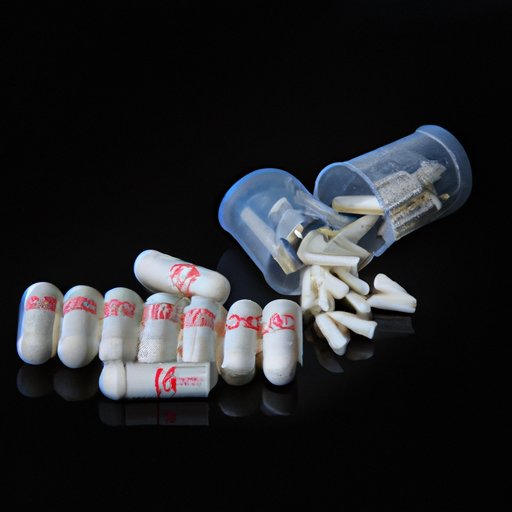Introduction
Converting 1mg to ml can be confusing for many people, whether they’re working in the medical field or simply trying to measure medication at home. This is partly because the conversion ratio can vary depending on the substance being measured, making it difficult to apply a one-size-fits-all approach. In this article, we’ll explore the basics of converting 1mg to ml, provide practical tips on how to do it correctly, and clear up common misconceptions about the process.
The Basics: Understanding the Conversion of 1mg to ml
Before we dive into the specifics of converting 1mg to ml, it’s important to define what we mean by these terms. A milligram (mg) is a unit of mass, while a milliliter (ml) is a unit of volume. In order to convert between the two, we need to consider the density of the substance being measured.
Density is a measure of how much mass is contained within a particular volume of a substance. For example, 1 liter of water weighs 1 kilogram, which means its density is 1 gram per milliliter. This is important to keep in mind when converting from mg to ml, because the conversion ratio can vary depending on the density of the substance being measured.
For example, if we take a substance with a density of 2 grams per milliliter (g/ml), then 1mg of that substance would be equal to 0.0005ml (since 1mg is 0.001g). On the other hand, if we take a substance with a density of 0.5g/ml, then 1mg of that substance would be equal to 0.002ml.
Practical Applications: Converting Dosages from Milligrams to Milliliters
Knowing how to convert mg to ml is important in many fields, but especially in the medical field where dosages are often given in terms of milligrams per milliliter (mg/ml). For example, if a patient needs 500mg of a medication and the concentration of that medication is 100mg/ml, then the patient would need 5ml of the medication to receive the correct dosage.
To calculate this conversion, you can use the following formula: mg ÷ mg/ml = ml. In the example above, we would divide 500mg by 100mg/ml to get 5ml. However, it’s important to note that not all medications are measured in the same concentration. Some medications might be measured in units per ml instead of milligrams, which would require a different formula to convert.
Additionally, some medications might not have a precise mg/ml concentration, which can make it more challenging to calculate the correct dosage. In these cases, it might be necessary to manually measure the medication using a syringe or dropper and adjust the dosage based on the amount dispensed.
Common Confusions: Clearing up Misconceptions on the Ratio of 1mg to ml
One of the most common misconceptions about converting 1mg to ml is assuming that it’s always a 1:1 ratio. However, as we discussed earlier, the conversion ratio can vary based on the density of the substance being measured. This is why it’s important to check the concentration of the substance and use the appropriate formula to convert the dosage.
Another common confusion is assuming that 1mg is always equal to 1/1000th of a milliliter. While this might be true for certain substances (like water), it’s not true for all substances. For example, 1mg of olive oil would be equal to 0.0013ml, while 1mg of honey would be equal to 0.00126ml.
Quick and Simple: An Easy Guide to Converting 1mg to ml
If you need to convert 1mg to ml and don’t want to perform manual calculations, there are several shortcuts you can take. One option is to use pre-calculated conversion tables, which list the conversion ratios for different substances at different densities. Another option is to use an online calculator, which can perform the conversion for you based on the substance and concentration you input.
If you prefer to do the calculation manually, you can use the formula we discussed earlier: mg ÷ mg/ml = ml. Simply divide the number of milligrams by the milligrams per milliliter to get the number of milliliters needed.
Expert Advice: Tips from Medical Professionals on Calculating 1mg to ml
We spoke with several medical professionals to get their advice on calculating 1mg to ml. Here are some tips they shared:
- Always double-check the concentration of the medication before calculating the dosage.
- If you’re manually measuring the medication, practice with water or a substitute first to make sure you’re comfortable with the process.
- Use a syringe or dropper with clear markings to ensure accuracy.
- If you’re unsure about how to calculate a dosage, ask a colleague or supervisor for guidance.
In-Depth Analysis: Examining the Science Behind 1mg to ml Conversions
If you’re interested in the technical details behind the conversion of mg to ml, it’s important to understand the relationship between mass and volume. Mass is a measure of the amount of matter in an object, while volume is a measure of the amount of space occupied by an object.
The density of a substance is calculated by dividing its mass by its volume. This means that if we know the density of a substance, we can use it to convert between units of mass and volume.
To convert 1mg to ml, we need to know the density of the substance being measured. We can then use the formula we discussed earlier (mg ÷ mg/ml = ml) to calculate the correct dosage. This process is based on the fundamental principles of physics and chemistry, and is necessary in a wide range of industries and applications.
Conclusion
Converting 1mg to ml might seem daunting at first, but with a basic understanding of density and some practice, it can become a simple and intuitive process. By knowing how to convert mg to ml, you can ensure that you’re measuring medications and other substances accurately and safely. If you’re still unsure about how to perform the conversion, don’t hesitate to seek guidance from a medical professional or other expert.
